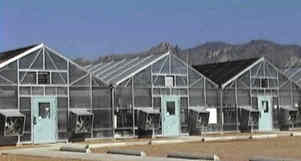

 There are many factors to consider
in determining the amount of greenhouse space you will need.
Amount of investment capital, training, the type of business,
environmental requirements, market, labor requirements and
personal preferences must all be evaluated. You should also be
aware of factors which are important in choosing a good building
site, such as drainage, accessibility, available utilities and
amount of sun exposure.
There are many factors to consider
in determining the amount of greenhouse space you will need.
Amount of investment capital, training, the type of business,
environmental requirements, market, labor requirements and
personal preferences must all be evaluated. You should also be
aware of factors which are important in choosing a good building
site, such as drainage, accessibility, available utilities and
amount of sun exposure.
There are companies such as Crop King who sell greenhouse packages which contain everything needed for turnkey operation. Greenhouse tomatoes with indeterminate growth habits are best managed in houses with high roofs. The structural design of a greenhouse must provide protection from wind, rain, heat and cold. The structural supports must be of minimal size to permit maximum light transmission to the crop while still supporting the structure itself, heating and ventilation units and the weight of the crop which is trained to grow up a support system carried by the greenhouse frame.
 There are a variety of types of
greenhouse covers. Glass is still a common glazing material.
Large panes reduce the shading of the crop from the support
frame. While shading may seem minimal in traditional greenhouses,
it is estimated that every 1% decrease in light will result in a
1% decrease in yield.
There are a variety of types of
greenhouse covers. Glass is still a common glazing material.
Large panes reduce the shading of the crop from the support
frame. While shading may seem minimal in traditional greenhouses,
it is estimated that every 1% decrease in light will result in a
1% decrease in yield.
Despite the common use of glass as a covering for greenhouses in Northwest Europe, glass remains inflexible, heavy, and expensive. Consequently, the hectarage of glasshouses on a world basis has remained static, (approximately 30,000 ha.) during the last 25 years. In contrast, the quantity of plastic used for greenhouses is increasing rapidly. Since polyethylene sheet film was first developed in England in 1938, it has been used widely in greenhouses because it is easy to work with and inexpensive. Worldwide, there are nearly 300,000 ha. of plastic greenhouses for growing high value horticultural crops.
Several other plastics have also been used for greenhouse glazings. Polyvinylchloride (PVC) has a very high emissivity for long wave radiation (similar to glass), which creates slightly higher air temperatures in the greenhouse during the night. The Japanese consider this improvement in thermal environment a benefit that outweighs the price advantage offered by the less expensive polyethylene (PE). The disadvantage of PVC is its narrow width as compared to PE, which may be manufactured in widths of up to15 meters. The narrow PVC sheets can be heat-welded together to form a large sheet, but this adds to the cost of the glazing material.
 The large sheets of PE can be
applied as an air-inflated "blanket" over a greenhouse:
two sheets of PE are separated by air pressure maintained by a
small continuously running fan. This arrangement provides
approximately 30-40% heat savings during winter. The
double-layer, air-inflated roof has also proven valuable in
regions with high winds or typhoons. It offers stability during
these conditions, saving the greenhouse and the crop during times
when structures covered only with one layer of plastic are often
lost and the crops damaged or destroyed. PVC film is not suitable
for air-inflated roofs because the air pressure stretches the
film and reduces its structural strength. Because PVC film is not
photodegradable, as is PE, environmental concerns about disposal
may diminish the use of PVC in Japan in favor of PE, which is the
predominant cover for greenhouses worldwide.
The large sheets of PE can be
applied as an air-inflated "blanket" over a greenhouse:
two sheets of PE are separated by air pressure maintained by a
small continuously running fan. This arrangement provides
approximately 30-40% heat savings during winter. The
double-layer, air-inflated roof has also proven valuable in
regions with high winds or typhoons. It offers stability during
these conditions, saving the greenhouse and the crop during times
when structures covered only with one layer of plastic are often
lost and the crops damaged or destroyed. PVC film is not suitable
for air-inflated roofs because the air pressure stretches the
film and reduces its structural strength. Because PVC film is not
photodegradable, as is PE, environmental concerns about disposal
may diminish the use of PVC in Japan in favor of PE, which is the
predominant cover for greenhouses worldwide.
 New materials such as double-skinned
panels made of polycarbonate and acrylic are becoming
increasingly popular. Unfortunately, their technical merit is
offset by high costs, making them affordable only in the
industrial nations of the world rather than in developing
agricultural communities.
New materials such as double-skinned
panels made of polycarbonate and acrylic are becoming
increasingly popular. Unfortunately, their technical merit is
offset by high costs, making them affordable only in the
industrial nations of the world rather than in developing
agricultural communities.
The ideal greenhouse "selective film" should do the following: